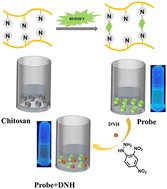Chitosan-bodipy macromolecular fluorescent probes prepared by click reactions for highly sensitive and selective recognition of 2,4-dinitrophenylhydrazine†
Abstract
Nitro compounds are widely used in modern industries. Among them, 2, 4-dinitrophenylhydrazine (DNH) is extremely harmful. It is of great significance to develop methods for the detection of DNH. In this work, chitosan was used as the substrate material, and fluoroborondipyrrole (BODIPY) was used as the fluorophore. Chitosan was endowed with the fluorescence sensing ability by the introduction of BODIPY units. First, BODIPY derivatives (NO-3 and BO-1) with an alkynyl group (C![[triple bond, length as m-dash]](https://www.rsc.org/images/entities/char_e002.gif) C) were synthesized. Second, small molecules NO-4 and BO-2 with an aldehyde group (–CHO) were obtained. Finally, the –NH2 groups on chitosan underwent a click reaction (–NH2/C
C) were synthesized. Second, small molecules NO-4 and BO-2 with an aldehyde group (–CHO) were obtained. Finally, the –NH2 groups on chitosan underwent a click reaction (–NH2/C![[triple bond, length as m-dash]](https://www.rsc.org/images/entities/char_e002.gif) C) and a Schiff base formation reaction occurred (–NH2/–CHO) to form three polymer probes C1, C2 and C3. C
C) and a Schiff base formation reaction occurred (–NH2/–CHO) to form three polymer probes C1, C2 and C3. C![[double bond, length as m-dash]](https://www.rsc.org/images/entities/char_e001.gif) C formed in the click reaction can interact with DNH and can be used as recognizing sites for DNH. These chitosan probes have good thermal stability and could selectively recognize DNH, showing notable fluorescence quenching effects, which are visible to the naked eye. DNH is a typical electron-deficient compound, and the polymer fluorescent probe contains electron-rich groups, which makes it easier for the two species to combine and cause fluorescence changes. C1 is flexibly cross-linked, C3 is rigidly cross-linked, and C2 has a non-crosslinked structure, and they show different rheological properties. This work expands the application of chitosan.
C formed in the click reaction can interact with DNH and can be used as recognizing sites for DNH. These chitosan probes have good thermal stability and could selectively recognize DNH, showing notable fluorescence quenching effects, which are visible to the naked eye. DNH is a typical electron-deficient compound, and the polymer fluorescent probe contains electron-rich groups, which makes it easier for the two species to combine and cause fluorescence changes. C1 is flexibly cross-linked, C3 is rigidly cross-linked, and C2 has a non-crosslinked structure, and they show different rheological properties. This work expands the application of chitosan.



 Please wait while we load your content...
Please wait while we load your content...